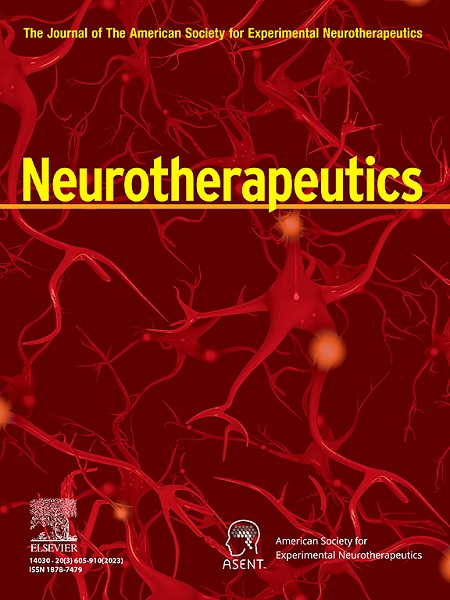Predictors of pharyngeal electrical stimulation treatment success in tracheotomised stroke patients with dysphagia: Secondary analysis from PHADER cohort study
IF 5.6
2区 医学
Q1 CLINICAL NEUROLOGY
引用次数: 0
Abstract
Pharyngeal electrical stimulation (PES) has emerged as a promising intervention for neurogenic dysphagia, with potential benefits in reducing dysphagia severity in stroke patients. PES may facilitate decannulation in tracheotomised stroke patients with dysphagia, yet the predictive factors for treatment success have not been investigated in detail. This study used data from the PHAryngeal electrical stimulation for treatment of neurogenic Dysphagia European Registry (PHADER) study to identify predictive factors for PES treatment success among patients with post stroke dysphagia who required mechanical ventilation and tracheotomy. Multiple linear regression was performed to predict treatment success, as measured in improvement in dysphagia severity rating scale (DSRS), accounting for age, sex, stroke type, lesion location, baseline National Institutes of Health Stroke Scale (NIHSS) score, feeding status, time from stroke onset to PES, PES perceptual threshold and PES stimulation intensity at the first session. Cox regression was conducted to identify the predictors for decannulation for all participants. Ninety-eight participants (mean [SD] age = 66.6 [13.0]; male 73.5%) were included in the analyses. Regression analyses showed that early intervention (p = 0.004) and younger age (p = 0.049) were significant predictors for treatment success. For participants who received PES during tracheotomy (n = 60; mean [SD] age = 66.6 [11.2]; male 73.3%), supratentorial stroke (p = 0.033) and feeding status at baseline (p = 0.025) were predictors of treatment success. Among all participants, early intervention was associated with higher likelihood of decannulation (p = 0.026). These results highlight the importance of timely intervention, age and stroke location in PES treatment success for stroke patients with mechanical ventilation and tracheotomy.
吞咽困难的气管切开中风患者咽部电刺激治疗成功的预测因素:PHADER 队列研究的二次分析。
咽部电刺激(PES)已成为治疗神经源性吞咽困难的一种很有前景的干预方法,在降低中风患者吞咽困难的严重程度方面具有潜在的益处。咽部电刺激可帮助气管切开的中风患者解除吞咽困难,但治疗成功的预测因素尚未得到详细研究。本研究利用欧洲神经源性吞咽困难PHAryngeal电刺激注册(PHADER)研究的数据,确定了需要机械通气和气管切开的卒中后吞咽困难患者中 PES 治疗成功的预测因素。在考虑了年龄、性别、卒中类型、病变位置、美国国立卫生研究院卒中量表(NIHSS)基线评分、喂养状态、从卒中发生到 PES 治疗的时间、PES 感知阈值和首次治疗时的 PES 刺激强度后,采用多元线性回归预测治疗成功率(以吞咽困难严重程度评分量表(DSRS)的改善程度为衡量标准)。我们对所有参与者进行了 Cox 回归,以确定取消通气的预测因素。98 名参与者(平均 [SD] 年龄 = 66.6 [13.0];男性占 73.5%)参与了分析。回归分析表明,早期干预(p = 0.004)和年龄较小(p = 0.049)是治疗成功的重要预测因素。对于在气管切开术中接受 PES 的参与者(n = 60;平均 [SD] 年龄 = 66.6 [11.2];男性占 73.3%),上脑卒中(p = 0.033)和基线时的喂养状态(p = 0.025)是治疗成功的预测因素。在所有参与者中,早期干预与更高的解禁可能性相关(p = 0.026)。这些结果凸显了及时干预、年龄和卒中位置对机械通气和气管切开的卒中患者 PES 治疗成功的重要性。
本文章由计算机程序翻译,如有差异,请以英文原文为准。
求助全文
约1分钟内获得全文
求助全文
来源期刊

Neurotherapeutics
医学-神经科学
CiteScore
11.00
自引率
3.50%
发文量
154
审稿时长
6-12 weeks
期刊介绍:
Neurotherapeutics® is the journal of the American Society for Experimental Neurotherapeutics (ASENT). Each issue provides critical reviews of an important topic relating to the treatment of neurological disorders written by international authorities.
The Journal also publishes original research articles in translational neuroscience including descriptions of cutting edge therapies that cross disciplinary lines and represent important contributions to neurotherapeutics for medical practitioners and other researchers in the field.
Neurotherapeutics ® delivers a multidisciplinary perspective on the frontiers of translational neuroscience, provides perspectives on current research and practice, and covers social and ethical as well as scientific issues.
 求助内容:
求助内容: 应助结果提醒方式:
应助结果提醒方式:


